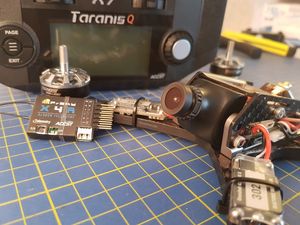Imagine a world where the skies are buzzing with drones, carrying delivery items to be sent directly to our doors.
A look into how courier services could soon become automated by unmanned vehicles has been revealed by IBM in their recent patent.

To extend the range of delivery drones and prevent packages from being pilfered, the technology giant patented a system under the license US Patent No. 9,561,852 that may allow drones to make mid-air transfers to one another.
Inventors at IBM developed this system using their supply chain expertise to allow precise services using drones (i.e. delivering packages from a warehouse to a customer’s home).
“Drones have the potential to change the way businesses operate and by leveraging machine learning, drones could change ecommerce,” said Sarbajit Rakshit, IBM Master Inventor and co-inventor on the patent.
While a number of companies have been working on almost similar package deliver systems for drones, this announcement seems to give IBM an advantage.
Inventors at IBM developed this system using their supply chain expertise to allow precise services using drones (i.e. delivering packages from a warehouse to a customer’s home).
“Drones have the potential to change the way businesses operate and by leveraging machine learning, drones could change ecommerce,” said Sarbajit Rakshit, IBM Master Inventor and co-inventor on the patent.
While a number of companies have been working on almost similar package deliver systems for drones, this announcement seems to give IBM an advantage.
What’s in the IBM drone system?
The system requires two connected drones from the shipper and the receiver that are operating autonomously under a single cloud-linked computer system. Each drone has the following features:
- A movable guide plate on the bellies to hold the package
- The retractable pole is tipped with an electromagnetic coupling device
- The top has an arm on a pivot with a docking mechanism

How does it work?
- Customer order an item and the warehouse ships it to them via drone.
- The customer will have to dispatch their own drone to receive the package mid-air at some point in between the two locations.
- When the drones meet, the shipper’s device lowers the parcel and it is received by the customer’s device by extending both their top arms to magnetically connect and secure the transfer.
- The two aircrafts tilt in synchronization to transfer the package.
- Once the package is transferred securely, the two drones undock and return to their respective bases.

Can this be done by today’s drones? Not yet, as most unmanned air vehicles on the market still have limitations. What we know so far is that the drone industry seems to be performing well.
Research by Gartner revealed that almost 3 million personal and commercial drones will be shipped this year. Thus, it’s not surprising that big tech companies, such as IBM and Samsung, are working closely to produce the most world-changing unmanned air vehicles.

The Korean tech company also hit the news for a patent request that describes a ducted fan style drone that is powered by a single large propeller. Unlike most quadcopters, this flat flying device doesn’t instantly break off or bend beyond usability on impact.
Unlike the IBM patent, Samsung’s drone seems to be targeting the travel and leisure industries. Their patented device comes with a forward-facing camera that opens up the possibility of a completely immersive flight through Gear VR that works well with their powered-up new handset. The Galaxy S8 boasting many premium specifications – 64-bit octa core processor, 4GB RAM, Bluetooth 5.0, and edge-to-edge display – that are perfect for viewing graphic-intensive VR environments. This technology has the potential to enhance how we travel in the future through virtual vacations without leaving the home.
Likewise, IBM’s drone patent also aims to enhance packaging and courier services, especially in reaching remote locations quickly.
Rakshit explained, “Our inventor team is focused on improving how the most valuable cargo is delivered globally. This could create opportunities such as managing drones to deliver postal packages and medicine in developing countries via the most direct route.”
Written by Aleah Kris for DroneTrest.com




